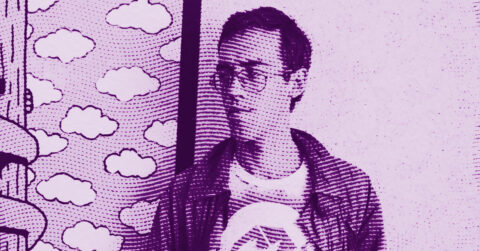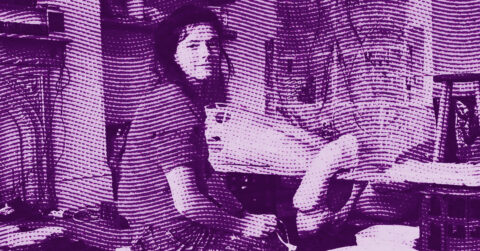Listen to me carefully, you bunch of snobs: while you gargle with the latest extravagances of the Western art market, a man in Tamale, northern Ghana, is weaving a poetics of ruin that brings down your comfortable certainties. Ibrahim Mahama does not play the game you expect from him. He refuses the codes, subverts expectations, and literally constructs a work that questions the very foundations of our material and narrative structures. Born in 1987, this artist does not content himself with creating monumental installations: he rewrites the rules of architecture and literature in a language made of worn jute sacks, abandoned wagons, and dilapidated hospital beds.
Let’s talk about architecture, since Mahama tackles it with a boldness that would make many contemporary builders blush. Where others are content to drape fabrics over façades to look pretty, he invests structures with a conceptual violence that shakes our spatial conceptions. His architectural interventions are not mere aesthetic gestures. They embody a material critique of colonialism and its failing infrastructures. When he wraps London’s Barbican with Purple Hibiscus, this massive installation of two thousand square meters of fabric, he is not decorating a building: he is symbolically strangling it under the weight of postcolonial history [1]. The gesture is brutal, almost suffocating, like the colonial legacies he denounces.
But architecture for Mahama is never just metaphorical. It becomes the ground for concrete social experimentation. With the Savannah Centre for Contemporary Art he founded in 2019, then Red Clay Studio and Nkrumah Volini, he erects spaces that defy Western conventions of the cultural institution. These buildings, constructed with sun-dried local clay bricks, do not aim to imitate the air-conditioned museums of Europe. Mahama asserts that art must think in relation to local conditions, and that quality is not inferior simply because it adapts to Ghana’s energy and climate constraints. This pragmatic yet radical architectural approach overturns the implicit hierarchy between North and South. His structures are not poor substitutes for Western institutions: they are alternative models that question the very relevance of the standards we consider universal.
Architecture in Mahama’s work also becomes an act of materialized memory. When he transforms colonial train wagons into classrooms and recording studios, he performs a kind of temporal surgery. These infrastructures, once instruments of British colonial extraction, metamorphose into educational spaces for local communities. The leather torn from the wagon floors, marked by decay and time, reveals wounds that become the very essence of the work. As he himself says, this leather looks like skinned flesh, bearing all the scars of a health system in crisis. This architectural transformation does not glorify anything: it exposes, dissects, reveals the traumas inscribed in the materials themselves.
But it may be in his approach to literature that Mahama displays his most formidable subtlety. Not that he writes, although he produces essays and theoretical reflections, but because he thinks of his work as a woven text, a material narration that dialogues with the great voices of African literature. When he titles an exhibition Purple Hibiscus after Chimamanda Ngozi Adichie’s novel [1], he is not merely making a cultural wink. He establishes a structural parallel between Adichie’s writing and his own practice. Adichie’s novel, published in 2003, tells the story of Kambili, a teenage girl living under the tyrannical authority of a father who is both a public philanthropist and a domestic abuser. The purple hibiscus in Aunt Ifeoma’s garden symbolizes freedom and rebellion against family and religious oppression.
Mahama understands that this rare flower carries exactly the same symbolic charge as his own recovered materials. His jute sacks, stamped “Product of Ghana”, traveled from Southeast Asia to transport Ghanaian cocoa, the country’s largest export resource at the beginning of the twentieth century. These sacks, like Adichie’s purple hibiscus, embody a form of subtle resistance, a beauty defying oppressive structures. They bear traces of forced labor, imposed migration, and systematic exploitation. By assembling them with local collaborators to create monumental patchworks, Mahama practices a form of collective writing, a narration sewn thread by thread.
Just as Adichie employs Igbo within her English to create a hybrid language that rejects colonial hegemony, Mahama mixes colonial materials (imported sacks, British rails) with local techniques (manual weaving, clay construction). This material narrative strategy creates a formal vocabulary that speaks multiple languages simultaneously. The work becomes polyphonic, refusing the stylistic purity that the Western art world would want to impose. He also cites Chinua Achebe by titling certain works after the Nigerian novelist’s titles, thus creating an intertextual network that anchors his work in the African literary heritage [2].
This literary dimension is not limited to borrowed titles. Mahama practices what could be called a “material reading” of history. His works function as non-linear narratives where each object carries a narrative layer. Recovered school desks, shoeshine boxes, fish-smoking nets: all these elements constitute a narrative vocabulary that tells stories of labor, migration, and economic survival. Mahama declares that he is interested in the moment when the relationship between material and society breaks, thus revealing the system’s flaws. This attention to narrative rupture recalls modernist fragmentation techniques, but applied to the sculptural and architectural domain.
The notion of “ghosts” also runs through his work as a literary leitmotif. During the COVID-19 pandemic, he writes that “the promises of the present can begin with the ghosts of the future and the past” [3]. These ghosts embody unkept promises, aborted futures, abandoned infrastructures. They haunt his installations as ghostly characters populate Gothic novels. But unlike European Gothic, Mahama’s ghosts are political, economic, deeply rooted in postcolonial realities. They do not terrorize: they bear witness.
His working method itself evokes the processes of collaborative writing and editing. He buys materials from scrap dealers, dismantles them, studies them, reassembles them. It is a process of material rewriting, correction, annotation. Mahama speaks of a “time travel” to describe his approach: a way to navigate between past, present, and future by reactivating abandoned objects. This fluid temporal conception recalls the complex narrative structures of postmodern literature, where linear time dissolves in favor of interwoven temporal layers.
What makes Mahama truly subversive is his categorical refusal of the aesthetics of consolation. He does not offer you soothing metaphors about African resilience. He does not sublime poverty into exoticism for jaded collectors. On the contrary, his works retain roughness, dirt, signs of wear. The burlap sacks remain holey, stained, sometimes stinking. This aesthetics of embraced waste rejects the vocabulary of Western beauty while creating visually overwhelming compositions. It is a powerful paradox: monumental works made of debris, commanding respect while rejecting conventional grandeur.
The educational dimension of his work also deserves attention. Mahama invests the proceeds from his sales in the construction of community spaces. He transforms abandoned grain silos, decommissioned planes, prisons into learning spaces. This architectural and social practice may be his most radical work: creating the material conditions for future generations of artists to emerge. He states that when artistic communities are built, “these communities are filled with love.” A statement that may seem naive but takes its full weight when observing the concrete impact of his infrastructures in northern Ghana.
For here lies the heart of the matter: Mahama refuses the separation between artistic practice and social responsibility. He rejects the idea that African contemporary art should merely produce objects for international circuits. His spaces function as counter-institutions, laboratories where local intelligence prevails over imported models. He collaborates with carpenters, shoemakers, guards, tattoo artists, people whose skills are generally invisible in the art world. This collaborative approach produces works bearing the marks of multiple hands, multiple voices.
Western critics love to talk about “decolonization” as if it were an elegant intellectual posture. Mahama, however, concretely decolonizes: by reclaiming colonial infrastructures for repurposing, creating alternative economies around material recovery, training young people in northern Ghana rather than London or New York. His decolonization is not rhetorical: it is material, architectural, economic. Marie-Ann Yemsi, curator at Palais de Tokyo in Paris, precisely states that he “plays an immense role in the decolonization of the imagination” [4].
It would be tempting to end on an optimistic note, to celebrate Mahama as a hero of contemporary art, a role model for all. But that would betray the very spirit of his work. Because what Mahama offers us is not a tale of triumph, but a profound meditation on failure as fertile material. He himself says he is interested in failure both as material and as potential, in the idea that failure opens a portal to reread the world in which we live. This philosophy of productive failure overturns our heroic expectations. It suggests that it is precisely in the breakdown, in the rupture, in abandonment that opportunities for reinvention are found.
His rusted train cars, his worn hospital beds, his torn bags: all testify to systems that have failed. The colonial railway system that never served local populations. The underfunded healthcare system. The global economy that treats African raw materials as mere commodities. Mahama does not hide these failures. He exposes them, studies them, transforms them into tools for reflection. His works become autopsies of postcolonial capitalism, revealing the mechanisms of exploitation in the very texture of the materials.
What distinguishes Mahama from artists who are content to denounce is that he simultaneously builds alternatives. His art centers are not monuments to his own glory, but living infrastructures, in constant mutation. They host exhibitions that last six months to allow distant villagers to make the journey. They archive the work of Ghanaian artists from previous generations whose works were disappearing. They train children in programming, robotics, digital technologies while maintaining an anchoring in material practices.
In a world of contemporary art obsessed with novelty, Mahama practices a different temporality. His works look backward to imagine forward. They draw from the ruins of the past the materials of the future. This attitude toward time is neither nostalgic nor futuristic: it is archaeological and visionary simultaneously. He digs through the layers of colonial and postcolonial history to extract unexplored potentialities.
So yes, Ibrahim Mahama deserves our attention. Not because he represents contemporary African art (as if such a monolithic category existed), but because he proposes a radical overhaul of what art can do in the world. He reminds us that materials carry stories, that buildings are texts, that artistic gestures can build real communities. His work is a dazzling demonstration that art does not need to choose between intellectual rigor and social impact, between formal beauty and political engagement. It can be all that at once, in all its rough and magnificent complexity. And if that bothers you, so much the better: that was precisely the intention.
- Chimamanda Ngozi Adichie, Purple Hibiscus, Algonquin Books, 2003.
- Chinua Achebe, Nigerian writer (1930-2013), author notably of Things Fall Apart (1958), considered a founding text of modern postcolonial African literature.
- Ibrahim Mahama, contribution to the Messages of Hope series by Designboom during the COVID-19 pandemic.
- Marie-Ann Yemsi, curator of the exhibition Ubuntu, a Lucid Dream at the Palais de Tokyo in Paris.
















